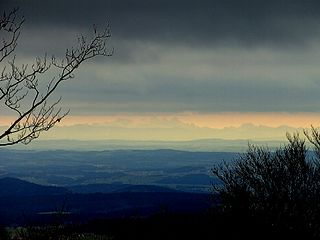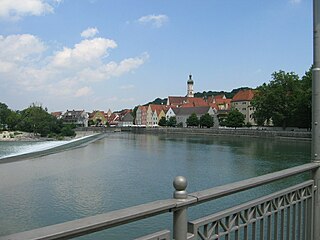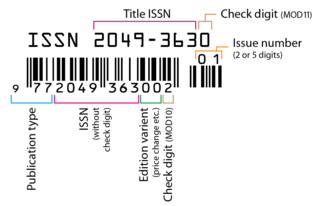
The Würm glaciation, in the literature usually just referred to as the Würm, often spelt "Wurm", was the last glacial period in the Alpine region. It is the youngest of the major glaciations of the region that extended beyond the Alps themselves. It is, like most of the other ice ages of the Pleistocene epoch, named after a river, the Würm in Bavaria, a tributary of the Amper. The Würm ice age can be dated to the time about 115,000 to 11,700 years ago, the sources differing depending on whether the long transition phases between the glacials and interglacials are allocated to one or other of these periods. The average annual temperatures during the Würm ice age in the Alpine Foreland were below −3 °C. This has been determined from changes in the vegetation as well as differences in the facies.

The Mindel glaciation is the third oldest glacial stage in the Alps. Its name was coined by Albrecht Penck and Eduard Brückner, who named it after the Swabian river, the Mindel. The Mindel glacial occurred in the Middle Pleistocene; it was preceded by the Haslach-Mindel interglacial and succeeded by the Mindel-Riss interglacial.

The Riss glaciation, Riss Glaciation, Riss ice age, Riss Ice Age, Riss glacial or Riss Glacial is the second youngest glaciation of the Pleistocene epoch in the traditional, quadripartite glacial classification of the Alps. The literature variously dates it to between about 300,000 to 130,000 years ago and 347,000 to 128,000 years ago. It coincides with the Saale glaciation of North Germany. The name goes back to Albrecht Penck and Eduard Brückner who named this cold period after the river Riss in Upper Swabia in their three-volume work Die Alpen im Eiszeitalter published between 1901 and 1909.

The Saale glaciation or Saale Glaciation, sometimes referred to as the Saalian glaciation, Saale cold period, Saale complex (Saale-Komplex) or Saale glacial stage, covers the middle of the three large glaciations in Northern Europe and the northern parts of Eastern, Central and Western Europe by the Scandinavian Inland Ice Sheet between the older Elster glaciation and the younger Weichselian glaciation.
The Gunz or Günz glaciation, also sometimes the Günz, Gunzian glaciation or Günz glacial stage, is a glacial stage of the Pleistocene epoch. It is the oldest glaciation of the Pleistocene in the traditional, quadripartite glacial classification of the Alps, although there are signs of even older glaciations in the Alpine Foreland, so that today it is reckoned that there were at least eight to 15 glacial periods. The name goes back to Albrecht Penck and Eduard Brückner, who named this ice age after the River Günz in their multi-volume work, Die Alpen im Eiszeitalter which was published between 1901 and 1909. Its type region is the Iller-Lech Plateau. The Günz followed the Danube-Günz interglacial and was ended by the Günz-Haslach interglacial.

Weichselian glaciation was the last glacial period and its associated glaciation in Northern Europe. In the Alpine region it corresponds to the Würm glaciation. It was characterized by a large ice sheet that spread out from the Scandinavian Mountains and extended as far as the east coast of Schleswig-Holstein, the March of Brandenburg and Northwest Russia.

The Alpine Foreland, less commonly called the Bavarian Foreland, Bavarian Plateau or Bavarian Alpine Foreland, refers to a triangular region of plateau and rolling foothills in Southern Germany, stretching from Lake Constance in the west to beyond Linz on the Danube in the east, with the Bavarian Alps forming its south boundary and the Danube its northern extent.

The Iller-Lech Plateau, also known as the Upper Swabian Plateau, is one of the natural regions of Germany.

The Calenberg is a hill in central Germany in the Leine depression near Pattensen in the municipality of Schulenburg. It lies 13 km west of the city of Hildesheim in south Lower Saxony on the edge of the Central Uplands. It is made from a chalk marl slab (Kalkmergelbank), has a height of 70 m above NN and was formed almost 100 million years ago at the beginning of the Upper Cretaceous series in Cenomanian stage. The Calenberg became historically important as a result of the fort, stronghold and castle built as the main residence of the House of Hanover.
The glacial series refers to a particular sequence of landforms in Central Europe that were formed during the Pleistocene glaciation beneath the ice sheets, along their margins and on their forelands during each glacial advance.

The Barnim Plateau is a plateau which is occupied by the northeastern parts of Berlin and the surrounding federal state of Brandenburg in Germany.

The Hohe Munde is a 2,662-metre-high (8,734 ft) mountain at the eastern end of the Mieming Chain in the Austrian state of Tyrol. It has two peaks: the west top (2,662 m) and the east top or Mundekopf (2,592 m).
An alpentor in geology is the point where an entire glacier forced its way through to the Alpine Foreland from the Alps during the ice age.
The Waalian interglacial was an interglacial period in northern Europe that lasted from about 1.45 million to 1.20 million years ago. It thus lies entirely within the Old Pleistocene and is thus part of the Cenozoic. Its name is derived from a major branch of the Rhine delta, the Waal. The Waal warm period could correspond temporally to the Danube-Gunz interglacial of the northern Alpine Foreland.
The Danube glaciation or Donau glaciation, also known as the Danube Glacial (Donau-Glazial), is a glacial stage of the Pleistocene epoch. It does not appear in the traditional, quadripartite ice age schema of the Alps by Albrecht Penck. The Danube stage was named by Barthel Eberl in 1930 after the River Danube. The Danube Glacial is the oldest glaciation in the Alps for which there is evidence outside of the Iller-Lech region. The Danube Stage was preceded by the Biber-Danube interglacial and followed by the Danube-Günz interglacial.
The Haslach glaciation, also Haslach Glacial Stage (Haslach-Glazial), Haslach Complex (Haslach-Komplex) or Haslach Ice Age (Haslach-Eiszeit), is a cold period of the Pleistocene epoch. It was not included in the traditional glacial schema of the Alps by Albrecht Penck and Eduard Brückner. The glacial stage was first described around 1981 by A. Schreiner and R. Ebel. Its type region is the Haslach Gravels (Haslach-Schotter) in the area of the Riß-Iller-Lech Plateau. The Haslach cold period was preceded by the Günz-Haslach interglacial and followed by the Haslach-Mindel Interglacial.
The Biber-Danube interglacial or Biber-Danube warm period (Biber-Donau-Warmzeit) is the oldest named warm period of the Pleistocene epoch in the Alps. It falls between the Biber and Danube glaciations.
The Danube-Gunz interglacial, Danube-Gunz warm period (Donau-Günz-Warmzeit), often just Danube-Gunz, or also Uhlenberg interglacial (Uhlenberg-Warmzeit) is the second-oldest named warm period of the Pleistocene in the Alps. It lies between the Danube and Gunz glacials.
The Gunz-Haslach interglacial, also Gunz-Haslach warm period (Günz-Haslach-Warmzeit), is one of the warm periods of the Pleistocene in the Alpine region. It lies between the Gunz and Haslach glaciations.
The Haslach-Mindel interglacial, also called the Haslach-Mindel warm period (Haslach-Mindel-Warmzeit), is a warm period of the Pleistocene in the Alpine region. It lies between the Haslach and Mindel glacial stages.
















